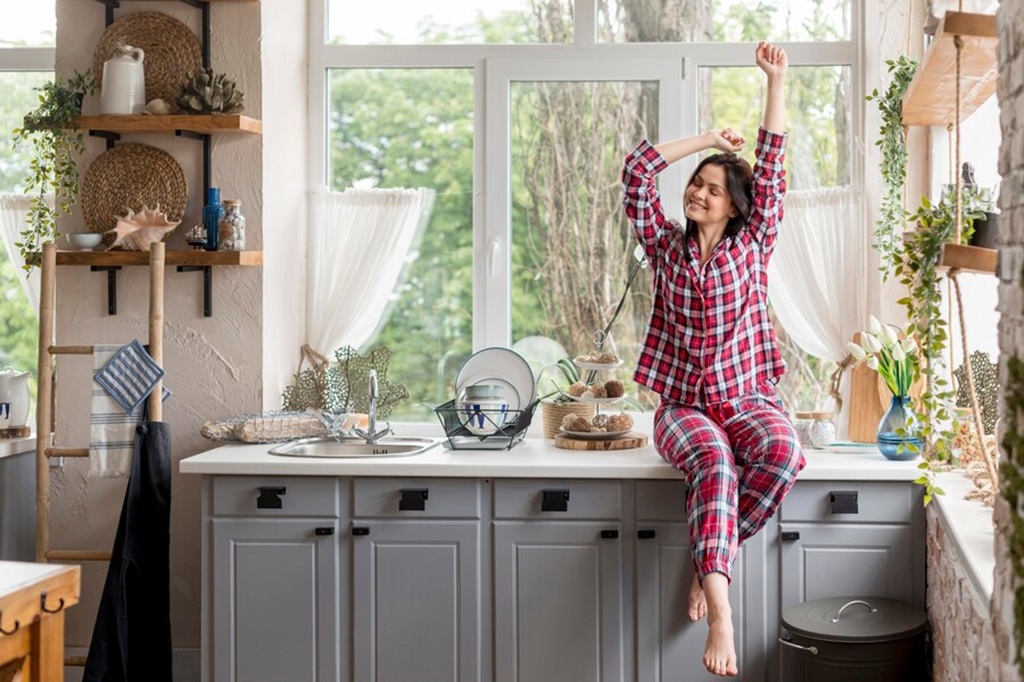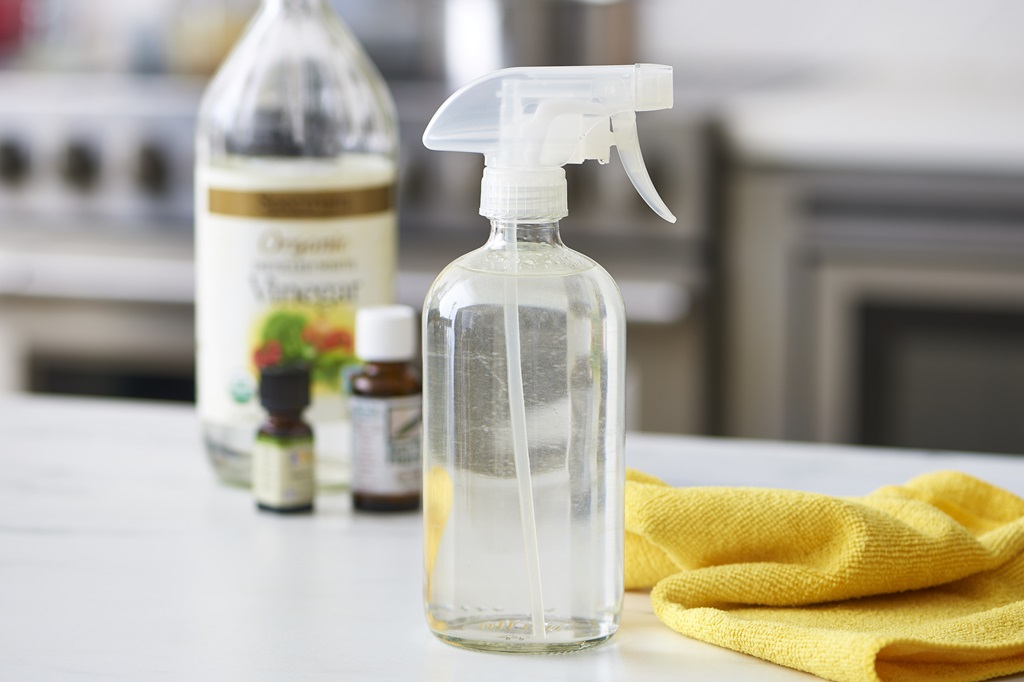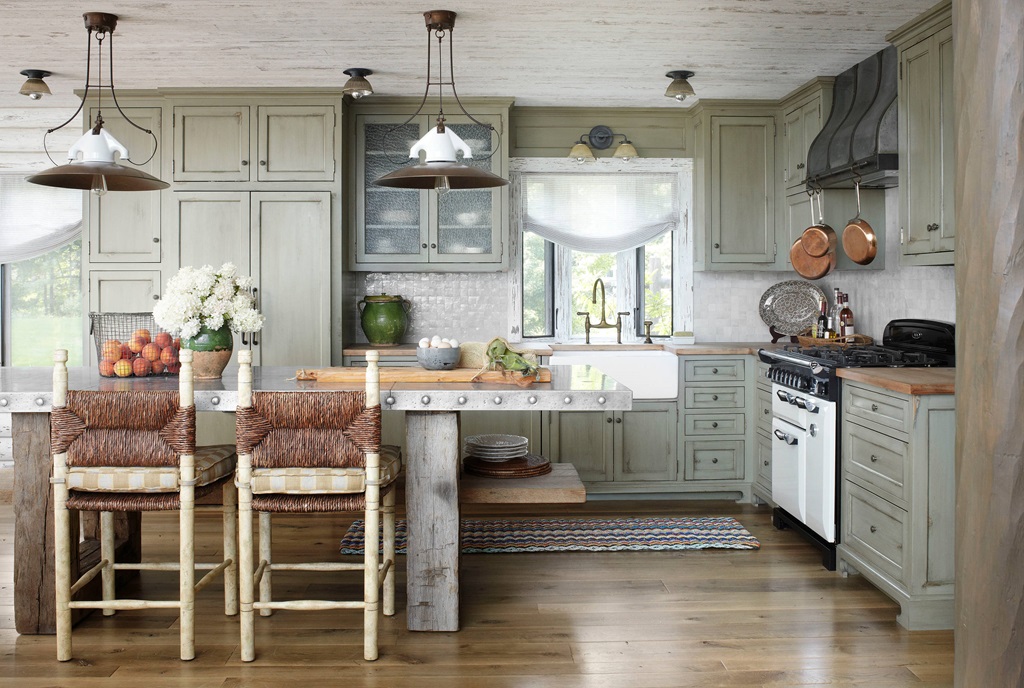
24 Dec Best and Safest Ways to Clean Rustic Kitchen Cabinets
Rustic kitchen cabinets made from natural, unfinished wood instantly add cozy appeal and unique character to any kitchen. Unlike conventional cabinets with smooth surfaces and uniform stains, rustic cabinets highlight the natural grain, knots, splits, checks, nail holes, and color variations of reclaimed or distressed woods. While this imperfect beauty is part of their charm, it also makes them more challenging to clean and care for than typical manufactured cabinetry.
Fortunately, with the right techniques and solutions, you can safely clean your rustic cabinets without damaging the authentic patina and texture that gives them their special style. This guides shares insider tips to help you maintain and protect the natural beauty of your rustic wood cabinets.
Be Gentle Yet Thorough Rustic Kitchen Cabinets Cleaning
When tackling any cleaning task for rustic cabinets, a light, careful touch is key. Avoid applying too much pressure or friction that could scratch or further wear the vulnerable wood. Dampen a microfiber cloth to wipe away dry debris and surface dust rather than rubbing vigorously. Pay special attention to cracks, corners, and carved details that can trap grease and grime. Use cotton swabs for precision cleaning of hard-to-reach spots.
Though a delicate approach is imperative, resist holding back too much. Lifting away all soil allows wood to breathe, protects finish and prevents buildup that leads to deeper staining over time. Be sure to move methodically from top to bottom when wiping cabinets down, repeating as needed until all visible debris is gone.
Kitchen Cabinet Cleaning Solutions
Water alone often isn’t enough cut through some types of kitchen grease and residue. Yet harsh chemical cleansers can damage delicate rustic finishes. Navigating between these two extremes is essential. Test any new cleaning product on an inconspicuous spot before tackling the entire kitchen. These gentle solutions lift most common types of dirt and grease safely:
Dish Soap – A small amount of mild dish soap diluted with warm water makes an excellent all-purpose rustic wood cleaner. Opt for a liquid soap without additives like bleach, antibacterial ingredients or fragrance. Castile-based liquid soaps are very gentle options.
Baking Soda – Sprinkle surfaces with baking soda, then spritz lightly with water or vinegar-water mix. Allow to set several minutes before wiping with a damp cloth. Baking soda alone can scrub away some grime, yet activates when combined with slight moisture or acidity to lift more stubborn grease and residue. Its mild alkalinity is safe for finished wood.
Olive Oil – Believe it or not, a very light application of olive oil moisturizes wood while lifting some soil from the surface. Apply with a lint-free cloth. Allow to set 10 minutes before buffing lightly with a clean, dry microfiber towel. The small amount of oil replaces lost moisture while dissolving some grime, but won’t leave an oily residue or go rancid.
Hydrogen Peroxide – As another mild yet effective cleaning agent for delicate surfaces, hydrogen peroxide can be used straight or mixed half and half with water in a spray bottle. Lightly mist soiled areas, allowing solution to set several minutes before wiping with a damp microfiber cloth. Rinse with a separate water-dampened cloth. Hydrogen peroxide effervesces while oxidizing to lift stains.
Vinegar – White vinegar kills bacteria and dissolves grease, sticky grime, and hard water deposits. Create a 50/50 vinegar-water solution. Dip a clean cloth into the mix and gently wipe rustic cabinet surfaces. Rinse with clear water, then immediately but gently dry with a towel to prevent streaks. Equal parts vinegar and olive oil also combine these grime-cutting and nourishing ingredients.
Avoid Harsh Abrasives

It can be tempting to use the strongest cleanser for the most stubborn crusted bits in neglected rustic cabinets. Yet powerful commercial degreasers, alkaline tub and tile sprays, scouring powders and anything acidic will likely damage natural wood over time, eroding any protective top coat.
Steer clear of cleaning products containing these potentially harmful ingredients:
- Bleach and chlorine compounds
- Ammonia
- Acids like oxalic or citric acid
- Hydrochloric acid
- Abrasive detergents
- Alkaline cleaners
- Solvents like acetone, turpentine or naphtha
- Lye or caustic alkalis like calcium hydroxide
It’s also smart to keep any commercial wood cleaning product containing lemon oil, tung oil or linseed away from rustic cabinets. While these oils can condition some finished wood pieces, they will lead to a buildup of sticky residue on porous unfinished cabinetry over time that attracts rather than repels dust and dirt. Unfinished wood needs to breathe, so steer clear of oil-based wood conditioners.
Be Cautious With Water
Take care not to drench rustic wood cabinets with water that could cause swelling, raise the grain, warp boards or leave behind mineral deposits. Avoid letting water pool on horizontal surfaces or inside cabinet interiors. Limit any water used for cleaning by first dipping cloth into solution rather than applying it directly. Immediately wipe with a separate dry cloth.
Use microfiber cleaning cloths rather than standard cotton rags or paper towels that could snag or shred delicate wood grain. Make sure no metal polish compounds come into contact with unfinished wood. The abrasives as well as moisture content poses risks for scratches and water marks. Carefully drying metal hardware installed in rustic cabinetry is also a must after cleaning to prevent future rust stains from bleeding onto nearby wood.
Protecting Your Investment
Don’t let meticulous cleaning make you lose sight of the inherent nature of rustic wood. Cabinets crafted from reclaimed barn boards, split logs and naturally weathered lumber will never have an evenly stained, flawless finish. Nor should they! Preserving the varied texture with nicks, nail holes and natural checking that lend antique character is key. But you can take some protective steps to help keep them looking their weathered best:
- Install cabinet ventilation slots or staggered interior shelves that promote airflow
- Keep kitchen properly ventilated with hood fan use while cooking
- Install indoor humidity monitoring system if in damp climate
- Avoid letting water or liquids sit on cabinet surfaces
- Use cutting boards rather than slicing directly on cabinet tops
- Keep cabinet doors open during spells of high humidity
- Apply beeswax conditioner every few years per manufacturer instructions
- Adjust any cabinet door hinge alignment issues right away
- Tighten loose knobs, pulls or handles causing rubbing issues
- Patch new nicks, gouges or scratches with stain markers
By using informed recommendations for cleaning agents and techniques, even the most rugged rustic kitchen cabinets can reveal unique beauty for years to come. Allow their vintage appeal to improve with age by letting the natural patina develop without trying to force changes unsuited to the wood’s character. With a caring, cautious approach your cabinets will reward you for decades.
Show Your Cabinets Some Love

Rustic cabinetry brings unique warmth and character to kitchens and commands caretaking to retain its natural beauty gracefully over years of use. By tailoring your cleaning approach to the vulnerable yet striking nature of the wood, your cabinets will continue looking attractively aged rather than simply worn out. Handle their finishes gently, nourish materials cautiously and address minor upkeep issues promptly to ensure your charming rustic kitchen cabinets withstand busy kitchen life in stride. The above tips will help you protect your investment while enjoying all the cozy appeal weathered woods add for years to come.
Frequently Asked Questions
What’s the best way to clean grimy splatters inside cabinets?
Grime tends to splatter and collect on interior cabinet surfaces closest to the stove and countertops over time. For light grease removal, dip a soft cloth into a baking soda paste made with just enough water to moisten. Gently wipe problem areas, taking care not to abrade delicate wood. Rinse with a separate damp cloth. For more stubborn accumulations, spray hydrogen peroxide solution. Allow to penetrate several minutes before wiping clean with a lint-free cloth.
Will vinegar or hydrogen peroxide bleach my cabinets’ patina over time?
In proper dilution with water and limited use frequency, white vinegar and hydrogen peroxide can be safely used without bleaching or damaging wood coloring. Always start with the mildest cleaning approach first, like dish soap and water, before trying anything stronger. Spot test unfamiliar cleansers in an inconspicuous area prior to overall use. Rinse immediately after application with plain water to avoid excess exposure.
Is it safe to use an electric leaf blower to dust kitchen cabinets?
Avoid using electric leaf blowers or excess blowing force to dry rustic cabinets, even on low settings. The concentrated air flow and pressure can push moisture deeper into unsealed wood grain and joints leading to cracks or finish lift over time. Instead, carefully wipe with a clean soft cloth after any light cleaning routine to lift dust and debris. Microfiber cloths trap more particles than they release.
What’s causing black spots to form on my cabinets? If you notice dark greasy splotches seeming to migrate across your cabinets’ surfaces, the likely culprit is a wax and dust buildup interacting. Avoid applying any wax, oil or polish products to raw rustic cabinetry, especially if near an existing grease issue. Use a cloth lightly dampened with hydrogen peroxide solution to gently lift residue; rinse and thoroughly wipe dry. Install an exhaust fan if lacking to minimize airborne kitchen grease settling onto surfaces.
Why do my cabinets feel tacky and smell odd?
A sticky, tacky feeling on your rustic cabinets likely indicates residue from cooking oils and grease accumulating faster than it can be cleaned away. The resulting chemical reaction with dust particulate and wood material emits unpleasant odors.
Tackle this stubborn buildup by mixing a non-sudsing ammonia solution of 1 cup ammonia diluted with 1 gallon of warm water. Working in a well-ventilated area, use a lint-free cloth to gently apply solution to affected areas. Allow 5 minutes contact time before rinsing clean and immediately drying with a separate microfiber cloth. This should cut through congealed layers of grease.
Follow up by installing upgraded ventilation like a commercial hood and fan above the cooking surface along with adding strategically placed attractant-type filters to capture more airborne particles before they settle and interact with cabinet surfaces again.
Can I use a Magic Eraser on my weathered cabinets?
It’s best not to use abrasive Magic Eraser-type cleaning pads on rustic, weathered cabinet finishes. The melamine foam material is too harsh for raw, aged wood and will scrape away delicate surfaces that are meant to show signs of natural wear. Instead, dissolve stubborn grime using a paste of baking soda and hydrogen peroxide. Apply to the affected area with a cloth, let set 5 minutes, then gently wipe clean with a soft brush and lint-free towel.
Will reapplying a stain help restore my cabinets’ color?
For cabinets showing excessive lightening of their stain or finish over time, re-staining can help provide visual renewal. However, darkening stained wood requires the removal of all existing top coats first for even absorption and true color accuracy. Sanding to bare surfaces is also best for applying stains that require penetration vs surface coatings such as paint. Consult a professional refinisher to determine the viability of your cabinets’ condition and preferred restoration approach.



Sorry, the comment form is closed at this time.